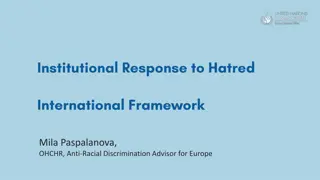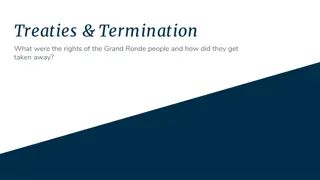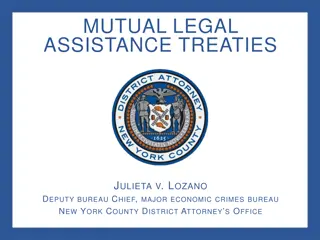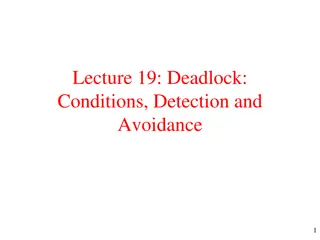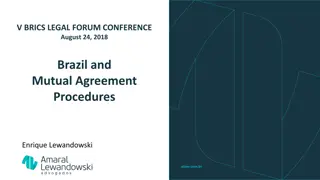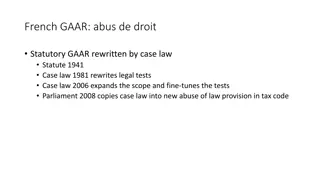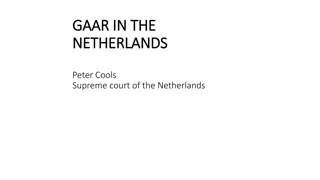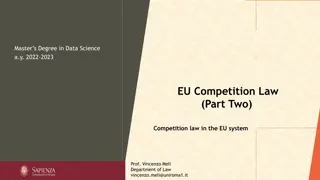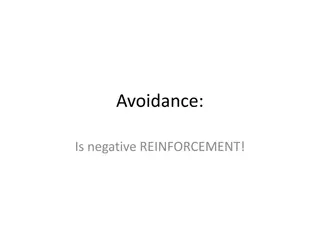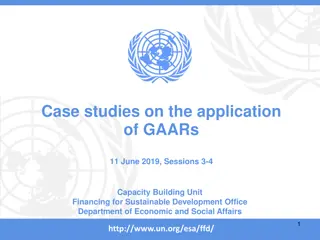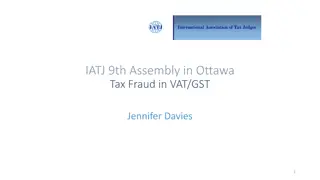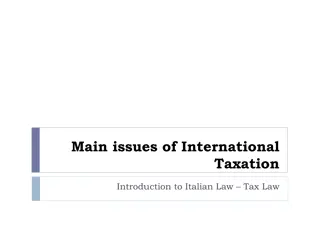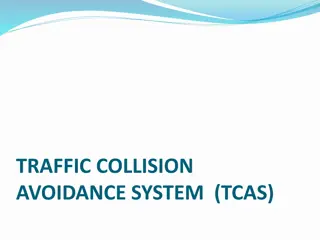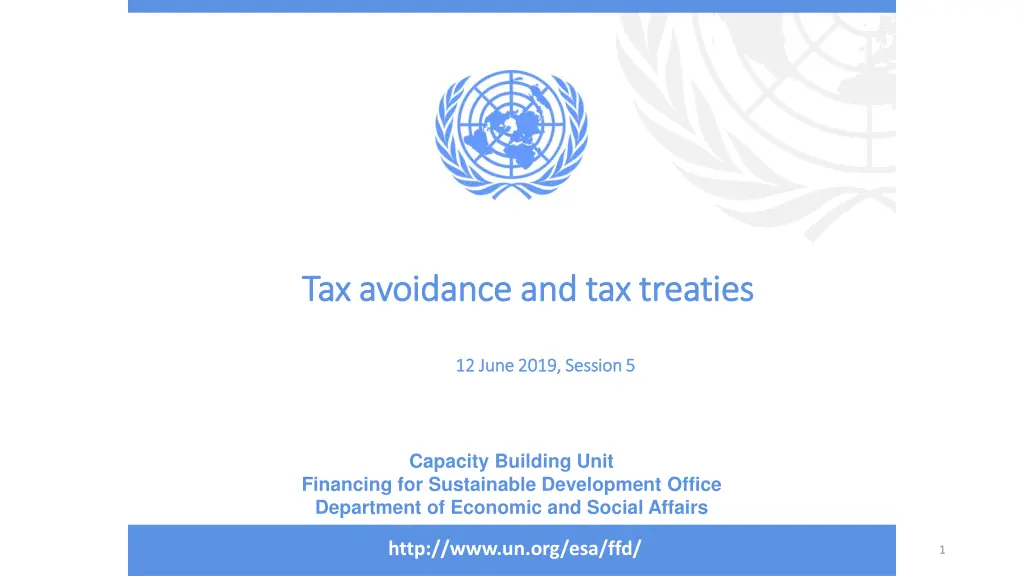
Understanding Tax Avoidance and Tax Treaties
Explore the concept of tax avoidance through tax treaties, including types of transactions, abusive practices, and ways to circumvent tax laws. Learn how entities use tax treaties to reduce domestic tax liabilities inappropriately and the implications of treaty shopping.
Download Presentation

Please find below an Image/Link to download the presentation.
The content on the website is provided AS IS for your information and personal use only. It may not be sold, licensed, or shared on other websites without obtaining consent from the author. If you encounter any issues during the download, it is possible that the publisher has removed the file from their server.
You are allowed to download the files provided on this website for personal or commercial use, subject to the condition that they are used lawfully. All files are the property of their respective owners.
The content on the website is provided AS IS for your information and personal use only. It may not be sold, licensed, or shared on other websites without obtaining consent from the author.
E N D
Presentation Transcript
Tax avoidance and tax treaties Tax avoidance and tax treaties 12 June 2019, Session 5 12 June 2019, Session 5 Capacity Building Unit Financing for Sustainable Development Office Department of Economic and Social Affairs http://www.un.org/esa/ffd/ 1
Tax treaties and tax avoidance Tax treaties are generally relieving Tax avoidance through the use of treaties is abusive where domestic tax is reduced inappropriately (i.e. where transactions are contrary to the object and purpose of the provisions of the treaty) Conceptually, abuse of a treaty is also an abuse of domestic law 2
Types of tax avoidance through tax treaties Most types of tax avoidance transactions through the use of treaties are the same as those with respect to domestic law: Shifting income to another country Converting one type of income into another Diverting income to related or non-arm s length persons Converting income into capital 3
Types of tax avoidance through tax treaties Establishing shell entity with nominal residence in a country The use of dual resident entities Triangular cases: payments received by resident of State A but attributable to PE in State B and State A uses the exemption method Avoidance of PE status 4
Types of tax avoidance through tax treaties Classification of income for tax treaty purposes arrangements to alter the character of amounts so that a more generous article of the treaty applies Circumvention of treaty thresholds (e.g. share ownership thresholds in Article 10(2) and 13(5)) Income and entities qualifying for preferential treatment 5
Types of tax avoidance through tax treaties Treaty shopping: taking advantage of a favourable tax treaty, often through the establishment of a controlled entity there Example: A, resident of Country A, assigns right to receive payment from C, resident in Country C, to B, A s agent or nominee, resident in Country B Treaty between Countries A and B but not A and C 6
Causes of tax avoidance through treaties Treaties generally prevail over domestic law Deficient treaty provisions (e.g. different rates for various payments; treaties are schedular) Inadequate enforcement efforts (treaties are specialized) Improper interpretation and application by the courts (e.g. literal interpretation) Widely differing treaties (treaty shopping) 7
Extent of tax avoidance through tax treaties Difficult to quantify Anecdotal evidence suggests that tax avoidance through treaty shopping and other strategies is widespread in both developed and developing countries 8
Addressing tax avoidance involving tax treaties Three basic ways to prevent or restrict abusive tax avoidance through the use of tax treaties: 1. include anti-avoidance rules in domestic law 2. include anti-avoidance provisions in tax treaties: Specific anti-avoidance rules General anti-abuse rule 3. interpretation of domestic law or treaties 9
Specific anti-abuse provisions in OECD and UN Models Beneficial owner" (in Articles 10, 11, and 12) Special relationship rule applicable to interest and royalties Rule on alienation of shares of immovable property companies (paragraph 4 of Article 13) Rule on the use of star-companies (Article 17(2)). Article 9 on transfer pricing (?) 10
BEPS specific treaty anti-avoidance rules in 2017 OECD and UN Models Limitation-on-benefits (LOB) rule to address a large number of treaty shopping situations based on the legal nature, ownership in, and general activities of, residents of a Contracting State Minimum shareholding period to prevent dividend transfer transactions (Article 10(2)) Changes to Article 13(4) to prevent transactions that circumvent the application of that rule dealing with capital gains on shares of immovable property companies (similar changes to Article 13(5) UN Model) 11
BEPS specific treaty anti-avoidance rules in 2017 OECD and UN Models Changes to the tie-breaker rule for determining the treaty residence of dual-resident entities Anti-abuse rule for permanent establishments situated in third States Article 29(8) Saving clause Article 1(3) allows countries to tax their residents without any limitation imposed by the treaty (subject to certain exceptions) 12
Relationship between domestic anti-abuse rules and treaties In case of conflict between the provisions of tax treaties and domestic law, the provisions of tax treaties must prevail Pacta sunt servanda Article 26 of the Vienna Convention: Every treaty in force is binding upon the parties to it and must be performed by them in good faith. Therefore, argument that treaties prevent the application of domestic anti-abuse rules in the event of a conflict Do domestic anti-abuse rules conflict with tax treaties? 13
Relationship between domestic anti-abuse rules and treaties Commentary on Article 1 of UN and OECD Models with respect to treaty abuse is very important Not legally binding but may be persuasive Since 1997 several developing countries have registered positions on the OECD Model Various versions of the Commentary on Article 1 since 1977 (OECD) and 1980 (UN Model) 14
Which version of the Commentary applies? Introduction to OECD Model (paras. 33 36.1) indicates that current Commentary applies to treaties previously entered into Many scholars disagree because treaty negotiators could not have been aware of subsequent version of Commentary when treaty concluded Issue has not been resolved in many countries 15
Which version of the Commentary applies? Current Commentary on Article 1 is clear that treaties do not prevent the application of domestic anti-avoidance rules and that treaties can be interpreted to prevent abuse However, there is a risk that courts may refuse to apply subsequent version of the Commentary to previously concluded treaties Therefore, it may be important for tax officials to know which version of Commentary applies 16
Which version of the OECD Commentary applies? 1977 1992 version: Up to states to adopt domestic rules to prevent preserve those rules in their 1992 2003 version: Position of large majority of countries is that domestic anti-avoidance rules apply to determine facts; not dealt with in treaties and not affected by treaties Minority view also recognized avoidance and then tax treaties 17
Which version of the OECD commentary applies? 2003 2017 version: A purpose of tax treaties is to prevent avoidance Treaties do not prevent application of domestic anti-avoidance rules Treaties can be interpreted to prevent avoidance Guiding principle (para. 9.5): Transaction considered abusive if a main purpose is to obtain treaty benefits and providing treaty benefits would be contrary to the object and purpose of the treaty 18
Which version of the OECD Commentary applies? 2017 version: Commentary on Article 1 revised significantly but fundamental treatment of treaty abuse retained Some countries consider abuse of treaty to also be abuse of domestic law; other countries consider some abuses to be abuses only of the treaty which must be dealt with by applying the provisions of the treaty Guiding principle retained (paragraph 61) 19
Which version of the UN Commentary applies? 1980 2001 version: One paragraph indicating that OECD Commentary followed with respect to abuse of treaties Therefore, onus on states to include provisions in treaties to prevent abuse 2001 2011 version; Same as OECD Commentary from 1992 - 2003 20
Which version of the UN Commentary applies? 2011 2017 version: Revised extensively; more consistent and comprehensive than 2003 OECD version Fundamentally same in substance as 2003 OECD commentary Identical guiding principle 2017 version: Basic approach maintained and refined Intended to be consistent with OECD 2017 21
2017 changes to UN and OECD Models New title mentions prevent of tax avoidance New preamble refers to the intention of the treaty partners not to create opportunities for non-taxation or reduced taxation including through treaty shopping Several new specific anti-avoidance rules New Article 29(9): general anti-abuse rule Incorporated into many bilateral treaties through the MLI 22

